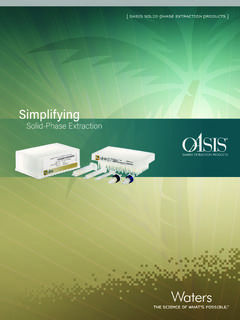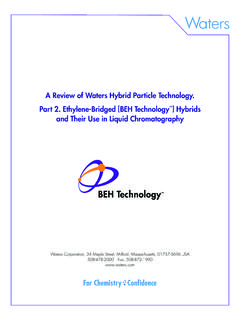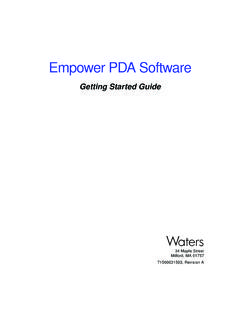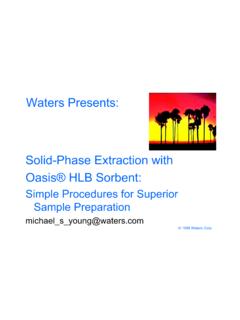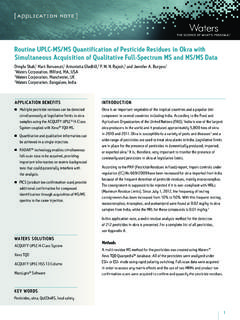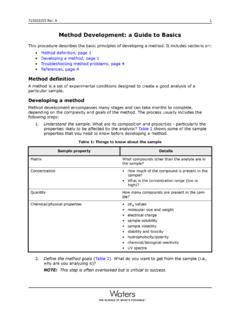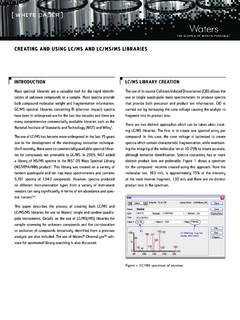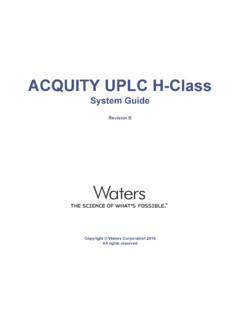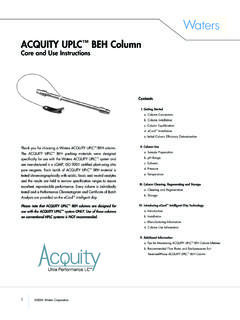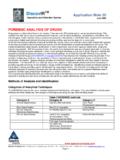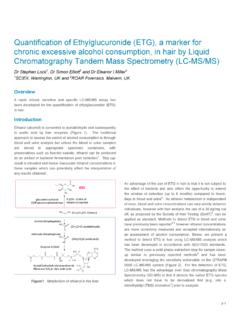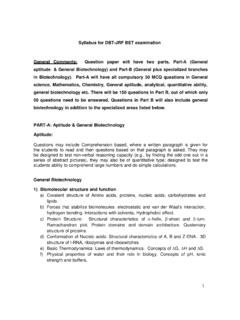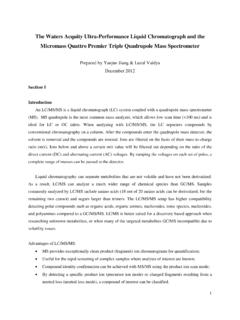Transcription of Ion chromatography analysis methods and issues - …
1 Slide #Ion ChromatographyAnalysis methods and IssuesJim KrolSr Applications Chemist for Ion AnalysisWaters CorporationFeb/Mar 2000 Slide #You Have a Choice forIon AnalysisIon AnalysisOptionsIonChromatographyCapillar y IonAnalysisSingle ColumnICChemicalSuppression ICSlide #Ion ChromatographyHardware Configuration OptionsConductivityDetectorAnion ExchangeColumnCIAC onductivityDetectorSuppressorModuleCondu ctivityDetectorSuppressorModulePhotodiod eArrayDetectorIon ExchangeColumnIon ExchangeColumnChromatographyManagerGradi entPumpAutosamplerGradientPumpAutosample rIsocraticPumpManualInjectorData SystemSlide #What Are Ions?Any chemical species that carries a electrical charge -Soluble in water -Exhibit conductivity in solutionExample: NaCl + H20 Na+ + Cl- + H2 ONa+ = Cation Cl- = AnionorNaH2PO4 + H2O Na+ + 2H+ + PO4-3 Slide #Importance of pH and pKaIons can exist in solution in a number of different formsDepending on pH of the solution and pKa of the ionH3PO4 H+ + H2PO4-1 pKa = H+ + HPO4-2 pKa = H+ + PO4-3 pKa = = -log [H+]pKa = the pH where the species is 50% ionizedSlide #Importance of pH and pKaWhy is this important to IC?
2 All ions in solution will convert to the formfavored by the pH of the ExchangeSlide #Importance of KspSolubility Product Before an ion can be analyzed by IC, it must be in on the sample matrix, other ions influence solubility. Ksp = [A-][C+] pKsp = -log Ksp [AC] Example: analysis of Cl in a sample matrix containing Ag, or analysis of SO4 in a sample with high for AgCl is implying that Cl is not in solutionKsp for CaSO4 is implying that only a portion of the SO4 is in #Important Questions to AskAbout the Sample1 What are the analyte ions of interest?2 What is the expected concentration?3 What else is in the sample matrix?Slide #Detection of IonsConductivity Direct: Net increase in conductivity.
3 Low background eluent conductivityIndirect: Net decrease in conductivityhigh background conductivityUV/VISD irect: Generally between 200 and 220 nmPost Column DerivatizationElectrochemicalSlide #Direct Conductivity DetectionConductivity of the analyte ionConductivity change due to displacement of eluentObserved conductivity response Analyte - Eluent = Equivalent Ionic ConductanceConductanceSlide #Indirect Conductivity DetectionConductivity of the analyte ionConductivity change due to displacement of eluentObserved conductivity response Analyte - EluentConductanceSwitch detector polarity for positive mV peaksSlide #What is Chemical SuppressionConductivity DetectionA Suppressor is a device placed between the column and the detector, and acts to reduce the background conductivity of the eluent and enhance the conductivity of the anion analysis .
4 The suppressor is a high capacity cation exchange membrane or resin in the acid removes cations from the eluent and replaces them with H+.The H+ neutralizes the highly conductive HCO3/CO3, or OH, to non-conductive H2CO3and H2O. Puts the anions into their highly conductive acid form for conductivity background conductivity and enhances anion #Mechanism of Chemical SuppressionAnion analysis Using Alltech ERIS1000 HPO=S=O_O_-H+O-O=S=O_O_-O+HO=S=O_O_H+O-H igh Capacity Cation Exchange Resinin the H form+O=S=O_O_-Na+O-O=S=O_O_-C+OO=S=O_O_- O+CNa+C+OH-A-HCO3-A-H+H2OH2CO3 FromColumn ToDetectorSuppression-Eluent ions, Na, OH, and HCO3/CO3exhibit high conductivity-Resin in H+ form acts to remove Na and Sample Cations, C+, from the eluent, and replaces them with H+-H+ interacts with OH and HCO3/CO3to yield H2O and H2CO3that have low conductivity and the conductivity of the eluent is significantly reduced-Simultaneously, the sample anions, A.
5 Are placed into their highly conductive acid form to enhance their conductivity response-Overall S/N and sensitivity is enhanced-Slide #Direct UV/VIS DetectionMany anions and all organic acids are UV active in the general range of 200 to 220 nmExamples: Nitrite, Nitrate, Sulfite, ThioSulfate, ThioCyanate Chlorite, Bromide, Bromate, Iodide, Iodate Arsenite, Arsenate, Selenite, Selenate, All Organic AcidsSlide #Direct UV Detectionin Series with Conductivity :Eluent:Flow rate:Injection V ol:W aters IC -Pak A/ H mM Na2CO3 mM mL/min50 LC onductivity w ithChemical SuppressionUV (PDA) at 214 nm1. Fluoride2. Chloride3. Nitrite4. Bromide5. Nitrate6. Phosphate7. Sulfate 1 ppm2 ppm4 ppm4 ppm4 ppm6 ppm4 ppm50 uSSlide #UV/VIS Detection withPost Column DerivatizationColumnReagentPumpMixingTee Rx CoilUV/VISD etectorAdditional hardware is necessary to the basic ICto do this type of applicationUsed for bromate with EPA , and fortransition metal analysisSlide #Ion ChromatographyApplications and MethodsCommon Anion analysis : EPA 300, Std Mtds 4110, & ASTM D4327;and Std Mtds 4140 & ASTM Dxxx using Capillary Ion AnalysisFluoride, Chloride, Bromide, Nitrite, Nitrate, o-Phosphate, and SulfateOxyhalide analysis : EPA & , ASTM pending Chlorite, Bromide, and BromatePerchlorate analysis : EPA 314 (?)
6 , no ASTM or Std MtdsChromate (Cr+6): EPA , or Std Mtds 3500, no ASTMA lkali/Alkaline Earth Cations: No EPA, Std Mtds, or ASTM Slide #IC Anion Exchange SelectivityVoRetention30 m inutesINORGANICANIO NSCATIONS ORGANIC ACIDSCO3 Detector ResponseAll EPA methods use an anion exchange column; Dionex or EquivalentWaters columns and Alltech ERIS 1000HP Auto Suppressorare considered equivalentNot all anion exchange columns are alike; selectivity and capacityWill require changes in eluent compositiondepending on the column capacitySlide #Ion chromatography for Anion AnalysisThe Validation IssuesHardware:The Ion ChromatographSoftware:Data ProcessingMethod:The ChemistrySensitivity and Detection LimitsLinearity and AccuracySystem Suitability:QA / QCSlide #Method Validation was Performed UsingWaters Alliance System for ICW aters 2690 S eparations M odule-316 Stainless Steel, low dispersion-Enhanced Flow Precision, RSD-Continuous Eluent Vacuum Degassing-Integrated Sample Management, at 100 LW aters IC -P ak A nion H R -6 m; mm x 75 mm.
7 PolyMethacrylate BasedWaters 432 Conductivity Detector-5 Electrode Design Providing High Sensitivity at High Background Conductivity-Direct Temperature ControlAlltech ERIS 1000HP AutoSuppresor-Tw o H igh C apacity C ation E xchange S olid P hase C ells in P arallel-Electrochemical Self-Regeneration with EluentW aters M illennium D ata P rocessing ( Equivalent Column)( Equivalent Suppressor Device)Slide #Alliance System forIon Chromatography2690 SeparationsModule withIntegratedSampleManagementAlltechERI S 1000 HPAutoSuppressor996 PhotoDiodeArray Detector(Optional)IC-Pak A HRMillenniumData ProcessingTypical EluentsBorate GluconateCarbonate BicarbonateNitric AcidDI WaterWasteColumnHeater@ 30 Co432 ConductivityDetector@ 35 Co AnionAnalysisSlide #Anion AnalysisMethod Validation Youden Pair Standards, in ppmAnalyte AnionThe collaborative design is intended to demonstrate performance and 50 ppm anion, except for Fluoride between and 25 9 is 100 ppb of each anion for detection limit Standards prepared from Certified 1000 ppm Stock StandardsSlide #Single Column Ion ChromatographyDirect Conductivity SColumn: Waters IC Pak A/HREluent: Borate / GluconateBack Cond: 240 SFlow Rate: 1 mL/minInj Volume.
8 100 L1 Fluoride = 1 ppm2 Bicarbonate3 Chloride = 24 Nitrite = 45 Bromide = 46 Nitrate = 47 o-Phosphate = 68 Sulfate = 4 Slide #Single Column Ion ChromatographyPeak Area Response LinearityChlorideFluoride0 10203040500E+05E+51E+62E+62E+63E+63E+6 Peak Areappm AnionBromideChloride r2 = r2 = r2 = Data Points per ConcentrationSlide #Single Column Ion ChromatographyPeak Area Response Linearity0 10203040500E+05E+51E+62E+62E+63E+6 Peak Areappm AnionNO2NO3NO2 r2 = r2 = Data Points per ConcentrationSlide #Single Column Ion ChromatographyPeak Area Response Linearity010203040500E+05E+51E+62E+62E+6 3E+6 Peak Areappm AnionSO4PO47 Data Points per ConcentrationPhosphate r2 = r2 = #Single Column Ion ChromatographyASTM Linearity01020304050010203040506070 Average Response Factor 5%Excellent LinearityResponse Factor (Peak Area/ /Conc)PO4 FSO4 Clppm AnionSlide # Single Column Anion Detection LimitsUsing the Alliance IC DipCationsFHCO3 ClNO2 BrNO3PO4SO4100 ppb Each Anion, 100 L Noise = SDetection Limits (ppb)
9 At 3 x S/NF = 50 NO3 = 75Cl = 25 PO4 = 125NO2 = 75 SO4 = 75Br = 75 Slide #Single Column ICPeak Area ConcentrationData as Peak Area %RSD for 7 Replicate Injectionsof Each StandardSlide #Single Column Ion ChromatographyAccuracy Using a Performance Evaluation Standard AnalyteFClNO2NO3PO4SO4 PerformanceEvaluationStandardTrueValuein et Chem & ICMeasuredStd SystemAve ICn= + + + + + + IC-Pak A HRIC/M B/G performance evaluation standards were purchased from APG Laboratoriesand diluted 1:100 with Type 1 DI measured results are the average from numerous laboratories using conventional,EPA approved wet chemistries and IC IC/True Value of indicates perfect agreement; Note PO4 = #Single Column Ion ChromatographyTypical Drinking SHCO3 = NaturalCl = ppmNO3 = = SSlide #Single Column Ion ChromatographyRecovery of Performance Evaluation Standardfrom Drinking WaterAnalyteFClNO2NO3PO4SO4 MilfordDrinking Watern=3, as + + + + PESn=3; as + + + + + + Performance evaluation standard was diluted 1:100 with typical drinking low recovery for PO4 is attributed to low ppb Mg, Ca, Fe, Mn, and Cu in thedrinking water.
10 Not from the stainless steel #Chemical Suppression Ion ChromatographyUsing Alltech ERIS 1000HP S1 Fluoride = 1 ppm2 Bicarbonate3 Chloride = 24 Nitrite = 45 Bromide = 46 Nitrate = 47 o-Phosphate = 68 Sulfate = 4 Column: Waters IC Pak A/HREluent: mM NaHCO3 / mM Na2CO3 Back Cond: 12 SFlow Rate: 1 mL/minInj Vol: 25 LWater DipSlide #01020304050ppm AnionPeak Area x 10+ Data Points per ConcentrationFluoride r2 = r2 = r2 = Suppression Ion ChromatographyUsing Alltech ERIS 1000HP AutosuppressorPeak Area Response LinearityFClSO4 Slide # Area x 10+6ppm AnionNitrite r2 = r2 = r2 = r2 = Data Points per ConcentrationChemical Suppression Ion ChromatographyUsing Alltech ERIS 1000HP AutosuppressorPeak Area Response LinearitySlide # PO4SO4100 ppb Each Anion, 25 L InjectionMinutesSystem PeakWater SDetection Limits (ppb)
